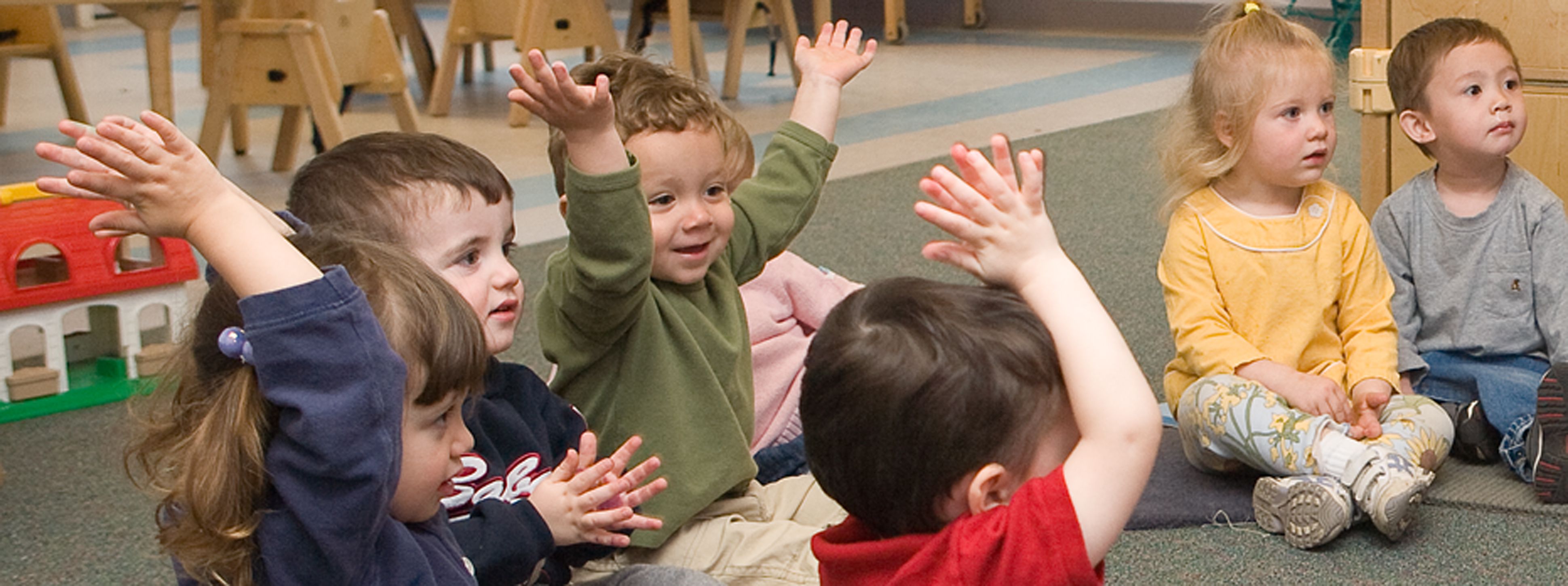Open Wide the Circle!
Musical Games for Early Learning
|
October 2016
You put your right hand in,
You put your right hand out,
You put your right hand in and you shake it all about
You do the Hokey Pokey and you turn yourself around
That's what it's all about!
Are you singing along yet? Are you putting your right hand in and out? Are you getting excited about putting your whole self in and shaking it all about? Do you remember playing the Hokey Pokey as a child?
What is it about musical games that make them so important in our growing up experiences? Why is it that you can recall a singing game you may not have thought about in years? There are several important things going on which imbed these games in our brains. Singing combines the music and language areas across the cortex of the brain, lighting it up. Musical games include movements, engaging kinesthetic learning. What’s in your body sticks in your brain! Singing games are played with a group—there is contagious laughter and a sense of belonging. Combining music with movement is a powerful learning tool that creates memories that will last for a lifetime.
Musical games are often passed from generation to generation orally so there can be different regional versions. Sometimes the tunes are a little different, and there may be additional verses or motions. Many of the games I have taught children over my long career as an early childhood music specialist are games I learned as a child from relatives, Girl Scouts, or on the playground. It doesn’t really matter which version you choose—dust off the ones you remember from your childhood! The important thing is that you make time every day to sing and play with the children in your care. Below are some tips and examples to help you get started:
Parallel Play Games
Parallel games are perfect for toddlers and three-year-olds. They follow a sequence, have a simple chant children can sing by themselves, and the directions for vigorous movement are built into the game. Nobody holds hands, there is no circle making to get in the way of play!
Teddy Bear, Teddy Bear
Teddy bear, teddy bear, turn around (turn around)
Teddy bear, teddy bear, touch the ground (bend down, touch the ground)
Teddy bear, teddy bear, tap your shoe (tap dance vigorously)
Teddy bear, teddy bear, that will do (clap three times on “that will do”)
Teddy bear, teddy bear, jump up high (JUMP with arms up)
Teddy bear, teddy bear, wave good bye (wave)
Teddy bear, teddy bear, climb the stairs (make climbing motions)
Teddy bear, teddy bear, say your prayers (fold hands or make a respectful posture)
Teddy bear, teddy bear, turn out the light (gesture turning out the lights)
Teddy bear, teddy bear say “good night.” (lie down, pretend to go to sleep)
“Good night! I love you.”
Teaching tip: I like to “tune up the orchestra” at the start of the game, so all the children are focusing on the starting pitch, and singing together. Here's how to do it: have the children wiggle their fingers in front of themselves while we sing “Oh-oh-oh-oh” on the starting tone. When we've all come together, start the song and game. Teach verse one, repeat verse one again and add verse two. Repeat verses one, two, three, and so on until you have completed the song so children have lots of practice learning the words and sequence.
Teaching tip: When we get to “touch the ground” I comment on the texture of the floor: “This rug is so soft.” “This floor is so shiny.” Even the most reluctant toddler wants to feel it.
Turn-Taking Games
When we offer children an opportunity to take the lead and stand in the spotlight for a few moments, we encourage their creativity. We model respecting the ideas of others when we watch carefully and repeat their motions. I learned this game from Amy Linder at Shady Lane School in Pittsburgh, and I think it’s a great one because it moves quickly, and uses the name of each child.
This is what I can do
This is what ______________ can do (insert child's name)
Everybody do it, too.
This is what ____________ can do
Now I pass it on to you.
(Children form a standing circle. As we sing the name of each child, she is to make a motion—hand clapping, leg patting, jumping, turning around, hopping on one foot, or a silly motion—anything that can be done safely in her imaginary “hula hoop” personal space. All the other children repeat her motion. Then the spotlight shines on the next child. This game works best if the adults have modeled the turn taking elements so the children know what is expected.)
Teaching tip: Some children are observers, and are not ready to sing or move with the group. Many of their parents have told me how their youngsters have taught the songs and games at home, so I know they need just a little more confidence to join the class. I invite and encourage children to participate, but I always allow them to “pass,” saying we would love to see your good ideas when you are ready to show us. This game is especially encouraging because no singing or speaking is required—just show your motion!
Stationary Circle Games
Stationary circle games are the musical variations of the childhood favorite “Duck, duck, goose” where children are in a circle, one child is “it” walking around the circle. Another child is chosen, and the chase is on!
Lucy Locket Lost Her Pocket
Lucy Locket lost her pocket
Kitty Fisher found it
Not a penny was there in it
Only ribbons 'round it.
(Prop needed—something to be the "pocketbook"—a pouch or bag with a few ribbons. I make it gender neutral! Children form a standing circle. The child who is "it" walks around the circle while the song in being chanted. When we get to "round it," he drops the bag behind another child, and runs! The other child picks up the bag and chases back to the open spot. For younger children, I ask the child who has had a turn to sit down in the circle, giving the child who is "it" a clear vision of which children still need a turn.)
Teaching tip: A counting out rhyme helps you to choose the first child to be "it”. Here's a favorite of mine. Ocka bocka soda cracker, ocka bocka boo, In comes Uncle Sam, and out goes Y-O-U.
Partner Games
Games requiring a partner give children the opportunity to take a social risk, approaching another child to pair up. Teachers' guidance is sometimes needed to facilitate selection, and my rule is that the first person who asks you is your partner.
The Big Ship Sails Down the Ali-Ali-Oh
Oh the big ship sails down the ali-ali-oh
The Ali-ali-oh, the ali-ali-oh,
Oh the big ship sails down the ali-ali-oh
High, ding dong day!
(This is a line game, which I usually teach in a hallway, so the children can visualize that they stand across from their partners with their backs up against the wall, forming a space down the middle. If you don't have a hallway available, use blue painter's tape to make two lines for the children to stand behind. The head couple holds both hands, and gallops sideways down and up and down the center of the lines, ending up at the opposite end from where they started. The new head couple takes a turn. The other children have a big job to be the clappers and singers. This game moves along very quickly, so we usually have each couple have two turns.)
Teaching tip: Most children gallop with their dominant foot forward, so if you are wondering if a child is left or right handed, watch them gallop. If they are especially awkward, have them try the other foot forward—you’ll be surprised at the difference!
Moving Circle Games
Moving in a circle is a more advanced skill so I usually start to teach these games to the older 4s. Be sure that you have practiced singing the tune before you learn the game!
Going to Kentucky
We're going to Kentucky
We're going to the fair.
To see the Senorita
With flowers in her hair.
So, shake it baby, shake it
Shake it all you can
Shake it like a milkshake,
And do the best you can!
Oh, rumble to the bottom,
Rumble to the top.
Turn around and turn around
until you make a stop!
(This game has the moving circle element, and featured children in the middle. I usually choose two or three children to be in the center using the counting out rhyme. The children in the circle hold hands, walking to the left for "We're going to Kentucky, we're going to the fair, to see the Senorita, with flowers in her hair." Then they stop and clap while the children in the center shake whatever part of their bodies they would like—they can shake a finger, shake arms, or shake all over! When we get to "Oh, rumble to the bottom" everybody rolls their hands down and up. Finally for "Turn around, and turn around until you make a stop" the children in the center close their eyes, point and turn around, picking new children to take a turn in the center. If someone has already had a turn, the closest person who hasn't had a turn is in the middle.)
Teaching tip: walking in a circle can be a challenging skill. Think of it—when you walk to the left, your eye sees the children across the circle moving to the right. I had found that taking the time to point your shoes in the direction you are walking helps! Some teachers like to have children practice walking in a circle holding on to a parachute to help with keeping the circle round. Sing a chant like "We’re walking in a circle, a circle, a circle. We're walking in a circle, we're walking round and round."
Again and Again and Again
You’ll find your children saying “Again! Again!” when they have experienced the fun of playing musical games together. Everyone is included, everyone is accepted. Rainy days when you can’t go outside to play become special when you play a favorite musical game. Clean-up time goes much more quickly when a singing game follows the tasks. Cooperation increases, laughter overflows. The class becomes more joyful! Try these new games, or dust off a few from your childhood, and open wide the circle!
For more information on the effects of music and brain development in children, you will find these articles interesting and engaging:
10 reasons why making music is good for your brain – Sidney Stevens.http://www.mnn.com/leaderboard/stories/10-reasons-why-making-music-is-good-for-your-brain
Babies' brains benefit from music lessons, even before they can walk and talk – McMaster University. https://www.sciencedaily.com/releases/2012/05/120509123653.htm
Early Music lessons boosts brain development. – Concordia College. https://www.sciencedaily.com/releases/2013/02/130212112017.htm
How the arts develop the young brain – David Sousa. http://aasa.org/SchoolAdministratorArticle.aspx?id=7378
Music improves baby brain responses to music and speech – Molly McEroy.http://www.washington.edu/news/2016/04/25/music-improves-baby-brain-responses-to-music-and-speech/
Texas Music Educators’ Keynote Address on the essential need for music – Dr. Karl Paulnack, video. http://www.tmea.org/resources/advocacy/materials/2013-keynote



